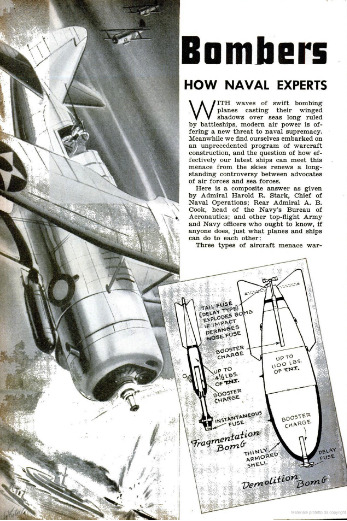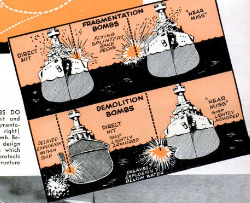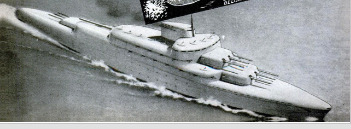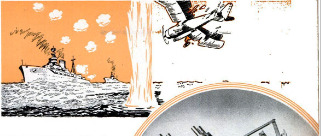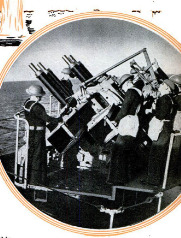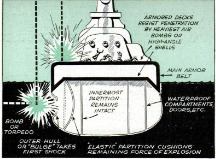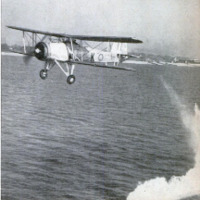-
Title (Dublin Core)
-
Bombers or battleships
-
Article Title and/or Image Caption (Dublin Core)
-
Bombers or battleships
-
extracted text (Extract Text)
-
WITH waves of swift bombing
planes casting their winged
shadows over seas long ruled
by battleships, modern air power is of-
fering a new threat to naval supremacy.
Meanwhile we find ourselves embarked on
an unprecedented program of warcraft
construction, and the question of how ef-
fectively our latest ships can meet this
menace from the skies renews a long-
standing controversy between advocates
of air forces and sea forces.
Here is a composite answer as given
by Admiral Harold R. Stark, Chief of
Naval Operations; Rear Admiral A. B.
Cook, head of the Navy's Bureau of
Aeronautics; and other top-flight Army
and Navy officers who ought to know, if
anyone does, just what planes and ships
can do to each other:
Three types of aircraft menace war-
ships, each in a specialized way—horizontal
bombers, dive bombers, and torpedo planes.
And each has its advantages and drawbacks.
‘Horizontal bombers attack their targets
from relatively high altitudes, aiming their
missiles with a precision bomb sight. The
size of these large multiple-engine craft
gives them great cruising radius and bomb-
carrying capacity. Flying miles high makes
them comparatively safe from a warship’s
antiaircraft fire.
But all is not on the side of the bombers
crew, by any means. For safety in altitude,
they pay in loss of bombing accuracy.
Viewed from 5,000 or 10,000 feet, even the
biggest warship makes a pretty small gray
speck upon the blue ocean. If they descend
to improve their chances of hitting it, their
own chances of getting hit by its five-inch
antiaircraft guns rise in exactly the same
proportion.
And here is a little-known fact. More
than half the time, clouds over the ocean
prohibit bombing from above 10,000 feet.
For days on end, unfavor-
able weather may keep the
“ceiling” much lower.
Even worse, a horizontal
bomber suffers from one
incurable weakness, owing
to its method of bomb sight-
ing. Just before dropping a
bomb, for a period variously
estimated from fifteen sec-
onds to more than a minute,
it must maintain an abso-
lutely fixed course and speed. This delights
antiaircraft gunners.
Dive bombers use entirely different tac-
tics. Power-diving almost vertically upon
their target at more than 400 miles an hour,
they release bombs at such low altitudes
that the projectiles can scarcely miss. In
this type of bombing, there need be no
elaborate corrections for altitude, wind, and
the speed and direction of the target. Only
the simplest sort of sight need be used; the
pilot virtually aims the bomb by aiming
the plane. A favorite stratagem is to “dive
out of the sun,” 8o that its glare blinds gun-
ners below.
But the dive bombers’ very style of at-
tack means flying down the barrels of all
the antiaircraft ordnance that can be
trained upon them. They run the gantlet,
not only of the big hand-loaded guns, but
also of the shorter-range multiple pom-
poms or “machine cannon” that throw a
continuous hail of small explosive shells,
much as a machine gun fires bullets. Then,
100, the terrific strain of
‘pulling the planes out of
their fast dives re-
quires bombers of this
type to be small ma-
chines. Because of their
diminutive size, their
capacity to carry bombs
is limited Likewise,
their curtailed weight
of fuel tethers them
within a short range of
their base. An admiral
who gives a respectful-
Iy wide berth to a “bee-
hive” of shore-based
dive bombers need have
little fear for his ships.
‘There remains the tor-
pedo plane. To launch
the torpedo slung be-
neath its fuselags, it
heads toward the broadside of
the vessel, skimming close to the
water. A likely hit requires a
dangerously close approach, un-
der heavy fire from the ship.
Shells striking the sea ahead of
the plane throw up great geysers
of water, which will shear off the
wings of an air raider plowing
into them at high speed.
Aircraft carriers of a fleet give
it additional and powerful pro-
tection against all forms of air
attack. Fighter planes sent aloft
by the hundred from carriers
may be able to destroy or ward
off the raiders before they reach
bombing positions.
But what happens if a warship
does have the bad luck to get
hit with an air bomb? Whether
minor damage results, or Davy
Jones's locker receives a new-
comer, depends both upon the
type of bomb used, and the class of ship.
“Fragmentation” bombs inflict casualties
among exposed personnel. Fused to explode
instantaneously, they hurl deadly fragments
of steel in all directions. If they miss a ship
and hit the water near-by, they still det-
onate in time to rake the deck with their
splinters. Because of their light weight—
thirty pounds or less—airplanes can carry
large quantities of them. For the same
reason, they effect little or no structural
damage upon a ship.
“Demolition” bombs, on the contrary, are
all that the name implies. They range in
weight from fifty to 2,000 pounds. Often
they are fitted with delay-action fuses, so
that they burst after penetrating the target
or the surface of the water. So adapted, a
bomb of this type acts in the same way as
a depth charge to destroy a thin-skinned
submarine. Spotted from the air while it
is submerged, an undersea craft is helpless
to fire back or, because of its limited speed,
to maneuver to dodge bombs. At the sur-
face, it is almost as vulnerable. In fact, re-
ports indicate that air bombers are almost
as effective antisubmarine weapons as the
sub chasers of the last war.
Destroyers and other small warcraft, too,
can be sent to the bottom by a direct hit
from a heavy demolition bomb. Their pro-
tection lies in their limited size as targets,
and their ability to throw off a bomber's
aim by fast, zigzag maneuvering.
Bigger ships, though better targets, have
more in their favor. Even an amateur math-
ematician will realize that, when you add
to a ship's size, the deck area increases only
as the square while the displacement and
therefore the weight of armor that can be
carried increases as the cube. This ex-
plains why great battleships can be armored
far more effectively than smaller craft
against air bombs.
Massive horizontal decks of armor plate,
placed as near as possible to the water line
to conserve stability, supplement the “belt”
or side armor of modern capital ships. Orig-
inally intended to protect the magazine and
other vital parts deep in the hull from high-
angle shellfire, this deck armor now serves
the added purpose of warding of air bombs.
In the newly launched 35,000-ton U.S. bat-
tleships Washington and North Carolina, it
is reported to attain the extraordinary total
thickness of ten inches. Even a 2,000-pound
demolition bomb, formidable as it. sounds,
shatters against such armor like an egg
dropped on a concrete pavement.
Special demolition bombs could be built
that would penetrate deck armor, but their
tremendous weight of steel would allow only
a small explosive charge. For gravity to
give the bombs sufficient velocity to pierce
the armor, planes would have to loose them
from an altitude corresponding to the 10,000-
foot-high trajectory of shells fired from
guns, reducing the chances of a direct hit.
‘And nothing else would do, for an armor.
plercing bomb dropping in the water near
a ship would carry too little explosive to
harm It.
In contrast, a standard thin-skinned dem-
olition bomb acts like a mine if it explodes
under water alongside a vessel. Multiple,
water-tight compartments are the battle-
ship's defense against
such a “near miss,”
and a damage-control
crew springs into ac-
tion to stop leaks, pump
out flooded compart-
ments, and restore the
ship to an even keel.
How to protect a big
ship's superstructure
against direct hits by
demolition bombs, which
may cripple if not sink
it, remains a major
problem confronting
the world’s admiralties.
One solution proposed
by naval architects en-
visions warships of the
future completely cov-
ered with turtleback
armor, with virtually
all the upper works re-
moved, and only the
muzzles of big guns
protruding from the carapace of steel! What-
ever form it may eventually take, however,
the majestic battleship remains the most
invulnerable of all surface craft—as has
been proved in actual bombing experiments
upon old, scrapped, and radio-controlled U.S.
capital ships. One had to be sent to the
bottom by shellfire after repeated bomb ex-
plosions failed to sink it. 5
And now, how do all the factors of air
power versus sea power add up? Evi-
dently the balance is close—unless the scales
are tipped violently, one way or the other,
by the particular mission of the sea or air
forces.
If shore-based bombers embark on a long-
distance raid against an enemy fleet, fuel
load will limit their bomb capacity. Lack of
escort planes, incapable of flying so far, will
Jeave them open to attack by defending
planes, as well as by antiaircraft fire. Loss
of valuable bombers is likely to outweigh
the military value of any damage they
might do.
CONVERSELY, an admiral would be
courting disaster by using his fleet to
force a landing, or cover an evacuation of
troops, within easy range of a powerful ene-
my air base. Only an emergency would jus-
tify the hazard. It is a comforting thought
that an invader’ fleet would face the same
warm reception from our own army's flying-
fortress bombers.
But this country’s grand stategy differs
as much from that of Europe as the vast
oceans that lap our shores contrast with
land-locked European waters. For our de-
fense, we picture
our Navy as engaging any enemy fleet far
out on the high seas, where land-based
planes play no part in the combat. It would
be the carrier planes of the two flcets that
would fight it out in the air, while the sur-
face craft joined battle below. So far as
carrier-based dive bombers or torpedo planes
could shake off attackers, and damage op-
posing warships, so much would that con-
tribute—even if not decisively—to the ulti-
mate outcome of the engagement. But it
would be joint action by sea and air that
counted, whether it was an air bomb or a
shell that finished off a hostile vessel.
So, from our own viewpoint, “air power”
and “sea power” become merged into one.
‘Taken separately, neither one completely as-
sures our security. Reénforcing each other,
they constitute a mighty defense team to
safeguard America.
-
Contributor (Dublin Core)
-
Alden P. Armagnac (writer)
-
Language (Dublin Core)
-
eng
-
Date Issued (Dublin Core)
-
1940-10
-
pages (Bibliographic Ontology)
-
52-56, 228
-
Rights (Dublin Core)
-
Public domain
-
Archived by (Dublin Core)
-
Sami Akbiyik
-
Marco Bortolami (editor)
 Popular Science Monthly. v. 137. n. 4. 1940
Popular Science Monthly. v. 137. n. 4. 1940

